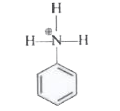Which does not show resonance ?
Benzene
Aniline
Ethyl amine
Toluene
The correct Answer is:C
To determine which compound does not show resonance among the given options (benzene, aniline, ethylamine, and toluene), we will analyze each compound step by step.
Step 1: Understand Resonance
Resonance is a concept in chemistry where a molecule can be represented by two or more valid Lewis structures. These structures differ only in the arrangement of electrons, not in the arrangement of atoms. Resonance structures help to describe the delocalization of electrons within a molecule.
Hint: Remember that resonance involves multiple valid Lewis structures that contribute to the overall structure of the molecule.
Step 2: Analyze Benzene
Benzene (C6H6) has a cyclic structure with alternating double bonds. It can be represented by two resonance structures, which show the delocalization of π electrons across the carbon atoms.
Hint: Look for cyclic compounds with alternating double bonds for resonance.
Step 3: Analyze Aniline
Aniline (C6H5NH2) has a benzene ring attached to an amino group (-NH2). The lone pair of electrons on the nitrogen can participate in resonance with the benzene ring, allowing for the delocalization of electrons.
Hint: Check if the molecule has a lone pair that can interact with a π system for resonance.
Step 4: Analyze Toluene
Toluene (C6H5CH3) is similar to benzene but has a methyl group (-CH3) attached. The resonance structures of toluene are similar to those of benzene, with the delocalization of electrons occurring in the benzene ring.
Hint: Methyl groups do not affect resonance; they can still allow for resonance in the benzene part of the molecule.
Step 5: Analyze Ethylamine
Ethylamine (C2H5NH2) has an ethyl group attached to an amino group. In this case, the lone pair of electrons on the nitrogen atom is localized and does not participate in resonance with any π system. Therefore, ethylamine does not exhibit resonance.
Hint: Look for compounds where lone pairs are localized and do not interact with double bonds or π systems.
Conclusion
Based on the analysis, the compound that does not show resonance is ethylamine (option C).
Final Answer
C. Ethylamine does not show resonance.
Resonance is a concept in chemistry where a molecule can be represented by two or more valid Lewis structures. These structures differ only in the arrangement of electrons, not in the arrangement of atoms. Resonance structures help to describe the delocalization of electrons within a molecule.
Benzene (C6H6) has a cyclic structure with alternating double bonds. It can be represented by two resonance structures, which show the delocalization of π electrons across the carbon atoms.
Aniline (C6H5NH2) has a benzene ring attached to an amino group (-NH2). The lone pair of electrons on the nitrogen can participate in resonance with the benzene ring, allowing for the delocalization of electrons.
Toluene (C6H5CH3) is similar to benzene but has a methyl group (-CH3) attached. The resonance structures of toluene are similar to those of benzene, with the delocalization of electrons occurring in the benzene ring.
Ethylamine (C2H5NH2) has an ethyl group attached to an amino group. In this case, the lone pair of electrons on the nitrogen atom is localized and does not participate in resonance with any π system. Therefore, ethylamine does not exhibit resonance.
Based on the analysis, the compound that does not show resonance is ethylamine (option C).
C. Ethylamine does not show resonance.
Topper's Solved these Questions
- CHEMICAL BONDING & MOLECULAR STRUCTURE BOOK - VMC MODULES ENGLISHCHAPTER - CHEMICAL BONDING & MOLECULAR STRUCTURE EXERCISE - IN-CHAPTER EXERCISE-J
10 Videos
- CHEMICAL BONDING & MOLECULAR STRUCTURE BOOK - VMC MODULES ENGLISHCHAPTER - CHEMICAL BONDING & MOLECULAR STRUCTURE EXERCISE - IN-CHAPTER EXERCISE-K
6 Videos
- CHEMICAL BONDING & MOLECULAR STRUCTURE BOOK - VMC MODULES ENGLISHCHAPTER - CHEMICAL BONDING & MOLECULAR STRUCTURE EXERCISE - IN-CHAPTER EXERCISE-H
10 Videos
- CHEMICAL BONDING & CHEMICAL STRUCTURE BOOK - VMC MODULES ENGLISHCHAPTER - CHEMICAL BONDING & CHEMICAL STRUCTURE EXERCISE - IMPECCABLE
50 Videos
- CHEMICAL BONDING-I & IIBOOK - VMC MODULES ENGLISHCHAPTER - CHEMICAL BONDING-I & IIEXERCISE - JEE Advanced (Archive)
98 Videos
Similar Questions
The resonance effect is defined as 'the polarity produced in the molecule by the interaction of two π-bonds or between a π-bond and lone pair of electrons present on an adjacentatom.' The effect is transmitted through the chain.
In positive resonance effect, the transfer of electrons is away from an atom or substituent group attached to the conjugated system. This electron displacement makes certain positions in the molecule of high electron densities. In negative resonance effect, the transfer of electrons is towards the atom or substituent group attached to the conjugated system.
Which of the following does not show resonance effect ?
View SolutionRoot does not show
View Solution
Knowledge Check
Which of the following molecules does not show any resonating structures?
ANH3BCO2−3CO3DSO3Among the following compounds, the one which does not show geometrical isomerism is :
AC6H5N=NC6H5BC6H5−CH=CHC6H5CC6H5−C∣CH3=N−OHDC6H5−C∣C6H5=N−CH3Which of the following compounds will not show resonance?
A BCH2=CH−CH=CH−⊕CH2C
BCH2=CH−CH=CH−⊕CH2C D
D
